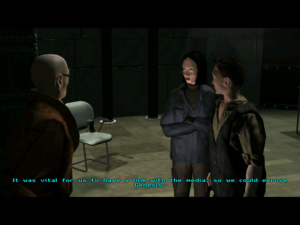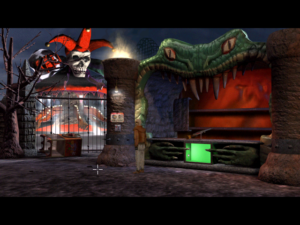Nightlong: VR
 At the end of disc 2 comes the twist that we’ve been expecting all along: the “terrorists” are not really terrorists and my employer has been hiding the truth from me. To be specific, the alleged terrorists are cyberspace researchers who stumbled on something called the “VST project”. They don’t know much about it, except that it involves virtual reality, that its chief architect, one Dr. Moreau (!), was recently killed, and that the Genesis corporation (and consequently the government and police) will stop at nothing to keep it secret.
At the end of disc 2 comes the twist that we’ve been expecting all along: the “terrorists” are not really terrorists and my employer has been hiding the truth from me. To be specific, the alleged terrorists are cyberspace researchers who stumbled on something called the “VST project”. They don’t know much about it, except that it involves virtual reality, that its chief architect, one Dr. Moreau (!), was recently killed, and that the Genesis corporation (and consequently the government and police) will stop at nothing to keep it secret.
The player character makes sympathetic noises and is accepted by the group. So either I’ve switched sides or the infiltration is a success. Either way, I’m still trying to get at the truth, and that involves going into cyberspace to see what Genesis is so eager to keep secret. Cyberspace is of course treated differently by different games. Seldom is the treatment at all sensible, but usually it’s more abstract and stylized than meatspace, with everything made of light and vectors. Not so here. The moment you uplink, you wind up in Moreau’s VR horror theme park.
 Being a future-tech fantasy of VR, it looks just like the game’s reality. The content is different from the main gameworld — fewer video monitors and flying cars, more floating castles and giant spiders — but the graphical presentation is the same. Even the player character’s cyberspace avatar is indistinguishable from the player character. Also, objects in the VR sim have the same physical and even chemical properties as the real objects they’re simulating: at one point, you mix up some simulated gunpowder out of simulated sulfur, simulated saltpeter, and simulated charcoal. (Which isn’t a surprise: the moment you see saltpeter in a game, you know that the gunpowder is inevitable. Just once, I’d like to see a game where you use it to make nitric acid or something. Not even Chemicus did that.)
Being a future-tech fantasy of VR, it looks just like the game’s reality. The content is different from the main gameworld — fewer video monitors and flying cars, more floating castles and giant spiders — but the graphical presentation is the same. Even the player character’s cyberspace avatar is indistinguishable from the player character. Also, objects in the VR sim have the same physical and even chemical properties as the real objects they’re simulating: at one point, you mix up some simulated gunpowder out of simulated sulfur, simulated saltpeter, and simulated charcoal. (Which isn’t a surprise: the moment you see saltpeter in a game, you know that the gunpowder is inevitable. Just once, I’d like to see a game where you use it to make nitric acid or something. Not even Chemicus did that.)
Maybe there’s an good in-story reason why the sim is such a good representation of the real world. Maybe the VST project is about doing a brains-in-vats/locked-in-the-holodeck scenario, where people don’t know that their reality is virtual. But then again, maybe this is just a case of the writer deciding that virtual reality is essentially just a parallel universe, and should naturally follow the normal physical laws. Which is stupid, but not uncommon in potboiler sci-fi.
 Comments(0)
Comments(0)